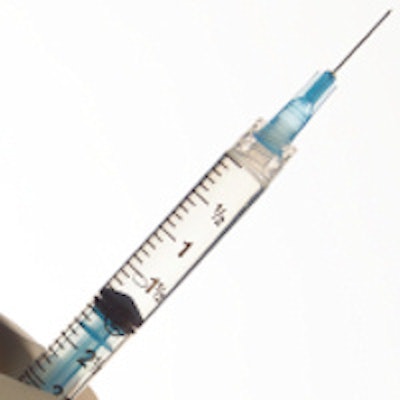
When patients need to have their impacted third molars extracted, many dentists choose to use either 4% articaine or 4% lidocaine hydrochloride to block their pain. But which is more clinically effective when treating these patients?
Using 4% articaine with 1:100,000 epinephrine was clinically more effective than using 4% lidocaine with 1:100,000 epinephrine for inferior alveolar nerve (IAN) block in a small, randomized, single-blind, comparative split-mouth study. The researchers reported that the articaine had a more rapid onset and lasted longer than the lidocaine in a study published in the Journal of Dental Anesthesia and Pain Medicine (March 2017, Vol. 17:1, pp. 29-35).
"The IAN block using 4% articaine was found to be more clinically effective in subjective and objective onsets of anesthesia than with using 4% lidocaine," the authors wrote.
The study was led by Kiatanant Boonsiriseth, DDS, of the department of oral and maxillofacial surgery in the Faculty of Dentistry at Mahidol University in Bangkok.
Impacted third-molar removal
Practitioners have used lidocaine in various formulations since 1948, while articaine was approved for use in the U.S. only in 2000. Yet no study has compared 4% lidocaine with 4% articaine, each combined with 1:100,000 epinephrine, for patients who need to have their impacted third molars extracted.
The researchers used panoramic radiographs to identify patients with symmetrically impacted lower third molars. Their study initially included 23 patients, and 22 completed the study (mean age of 21 years).
The patients were randomly divided into two groups:
- A study group, in which 1.7 mL of 4% lidocaine with 1:100,000 epinephrine was injected through the pterygomandibular space for the IAN block in the impacted lower third-molar surgery
- A comparative group, in which 1.7 mL of 4% articaine with 1:100,000 epinephrine was injected through the pterygomandibular space for the IAN block in the impacted lower third-molar surgery
Each patient had a lower third molar removed under local anesthesia, then returned to the same institution three weeks later to have the other impacted third molar removed by the same surgeon. No adverse events were detected during surgery or in the postoperative period.
“The inferior alveolar nerve block using 4% articaine was found to be more clinically effective in subjective and objective onsets of anesthesia than with using 4% lidocaine.”
"We chose a three-week interval between the surgeries in this study so that postoperative sequelae of the local anesthetic injection, such as pain and numbness, were reduced," the authors wrote.
The same dentist performed the IAN block injections on both sides. After adequate numbness was confirmed, another 0.3 mL of the same anesthetic was administered for the buccal nerve block.
Results showed that both substances had similar clinical efficacy, but that articaine showed a quicker subjective onset than lidocaine (134.86 ± 69.26 versus 253.95 ± 154.10 seconds). The researchers also found that the duration of anesthetic for articaine was about half an hour longer than for lidocaine (287.55 ± 82.79 versus 258.82 ± 81.76 minutes).
Using the 0- to -100-mm visual analog pain scale, patients in the articaine group reported experiencing more pain than those in the lidocaine group, according to the authors, but they noted that the intensity of intraoperative pain between the two groups was not statistically significant different. These results were reversed during suturing, as the lidocaine group experienced more pain than the articaine group. The difference, however, was again not statistically significant.
Surgical time also was not statistically different between the groups, the authors added.
Mixed results
While the authors did not note any study limitations, the small number of participants suggests larger studies are needed.
In their study, however, they found that the onset of anesthesia was the most significant difference.
"The main difference between the groups was in the subjective and objective onset of anesthesia, with 4% articaine demonstrating a more rapid onset than 4% lidocaine," the authors concluded.



















